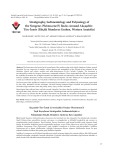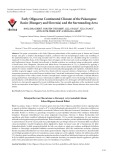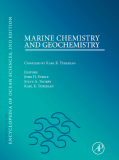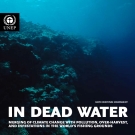
Continental carbonate
-
Part 2 book "An introduction to environmental chemistry" includes content: The chemistry of continental waters, the oceans, global change, the carbon cycle, the sulphur cycle, persistent organic pollutants, further reading, internet search keywords.
 156p
156p  muasambanhan10
muasambanhan10
 06-04-2024
06-04-2024
 2
2
 0
0
 Download
Download
-
The Payas region bauxite deposits occur as a sandwiched layer that is a few kilometers long and an average of 10 m thick between the lower and upper Cretaceous carbonates of the Arabian Platform. The bauxites occur as 2 types, comprising blanket and pocket, are chemically and texturally homogeneous, and have a thrust structure with ophiolitic mélange formations. The bauxite varies in color, from reddish-brown to grayish-green to black, and has a massive, patchy, and very rare oolitic-pisolitic texture.
 26p
26p  tanmocphong
tanmocphong
 29-01-2022
29-01-2022
 20
20
 1
1
 Download
Download
-
The basement rocks located in the central part of the southern edge of the Küçük Menderes Graben, around Akçaşehir-Tire are composed of marbles, schists, gneisses and metagabbros of the Ödemiş–Kiraz submassif of the Menderes Massif, and schists, marbles and meta-olistostromes of the Cycladic Complex.
 30p
30p  vidonut2711
vidonut2711
 09-11-2019
09-11-2019
 14
14
 2
2
 Download
Download
-
This paper concentrates on the Early Oligocene palaeoclimate of the southern part of Eastern and Central Europe and gives a detailed climatological analysis, combined with leaf-morphological studies and modelling of the palaeoatmospheric CO2 level using stomatal and δ13C data.
 34p
34p  vidonut2711
vidonut2711
 09-11-2019
09-11-2019
 8
8
 2
2
 Download
Download
-
Cold seeps occur in geologically active and passive continental margins, where pore waters enriched in methane are forced upward through the sediments by pressure gradients. The advective supply of methane leads to dense microbial communities with high metabolic rates. Anaerobic methane oxidation presumably coupled to sulphate reduction facilitates formation of carbonates and, in many places, generates extremely high concentrations of hydrogen sulphide in pore waters.
 46p
46p  japet75
japet75
 30-01-2013
30-01-2013
 34
34
 2
2
 Download
Download
-
established in the earliest history of the planet or as the result of a continuing supply of water and the constituents of sea water by degassing from the Earth’s interior. In 1951 W.W. Rubey, in his Presidential Address to the Geological Society of America, took the latter point of view. His arguments were colored by the knowledge available at that time of the age of the Earth and the age of the oldest rocks. Based on the analysis of lead isotopes in galenas, it was determined in the late 1940s that the Earth was about 3.2 billion years old.
 0p
0p  thienbinh1311
thienbinh1311
 13-12-2012
13-12-2012
 56
56
 8
8
 Download
Download
-
In this, the second volume of the two-volume review of carbonates in continental settings, we continue our survey of the important aspects of their formation and utilisation.Whereas the first volume emphasised the formation of carbonate sediments, covering the depositional settings, facies and sedimentological processes; this second volume examines the geochemistry, diagenesis, sequence stratigraphy of these deposits, along with some of the practical applications. The geochemistry of continental carbonates is discussed in depth in Chapter 1.
 321p
321p  xunu1311
xunu1311
 03-11-2012
03-11-2012
 64
64
 7
7
 Download
Download
-
In order to understand and manage our air quality resources, it is necessary to gain a fundamental understanding of the principles that govern our ability to do so. From a local perspective, it may be considered desirable to install huge fans in order to “blow the smog away,” but from a technological and scientific perspective it is not feasible. Likewise, from a regional or continental perspective, it is not acceptable to merely transfer air contaminants from one location to another one by dilution or “blowing it away.”...
 340p
340p  951628473
951628473
 07-05-2012
07-05-2012
 88
88
 17
17
 Download
Download
-
Continental shelves are the gently sloping areas of the ocean floor, contiguous to the continent, that extend from the coastline to the shelf-break. The shelf break, which is located around 150–200 meters depth, is the area of the continental margin where there is an abrupt change between the shelf and the steeper continental slope. Primary production in the oceans, i.e. the production of organic compounds from dissolved carbon dioxide and nutrients through photosynthesis, is often associated with upwellings (Botsford et al., 2006).
 64p
64p  lulanphuong
lulanphuong
 19-03-2012
19-03-2012
 62
62
 7
7
 Download
Download
CHỦ ĐỀ BẠN MUỐN TÌM






















